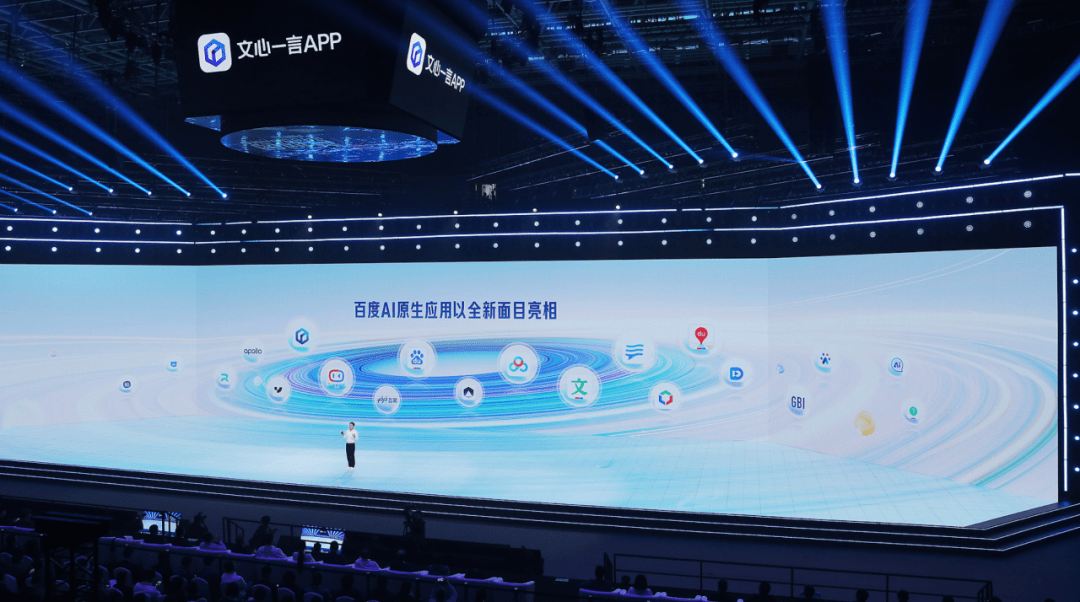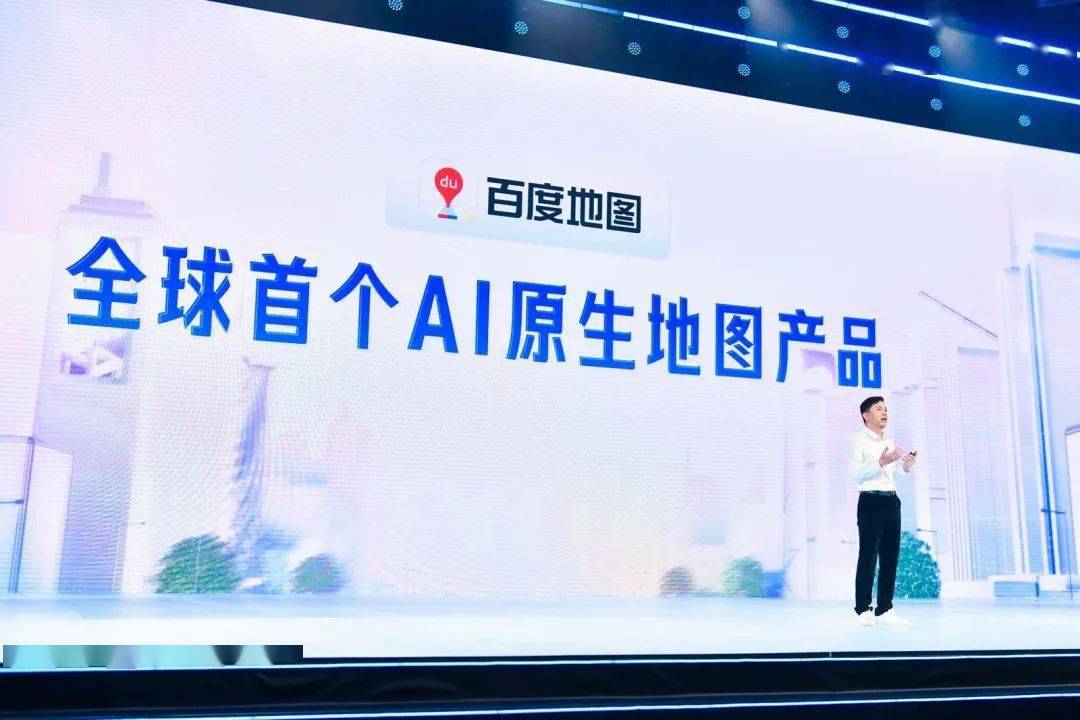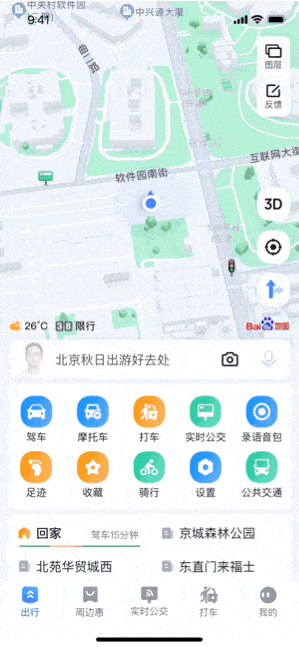

Riding on the express train of mobile Internet, map manufacturers have broken through the boundaries of electronic maps and found new development paths. However, as the Internet has become a "traditional industry", it is becoming increasingly difficult for the map navigation industry to undergo major changes, and the improvement of user experience continues to face challenges.
The arrival of large models has begun to loosen the somewhat solidified pattern.
At the Baidu World Conference on October 17, Baidu founder, chairman and CEO Robin Li announced the use of AI native thinking to reconstruct Baidu Maps. This 18-year-old navigation product once again overturned the past in the era of large models and became the world's first AI-native map.

According to Robin Li, Baidu Maps has been reconstructed from the two dimensions of "new interaction" and "new navigation", and has launched a new "AI Guide" function, which can interact with users in a real-person manner and support one sentence. Intelligently call many map functions and services, with one-stop access and quick response.
Not only a navigation, but also a travel guide for the public. In the post-Internet era, this "big" evolution of Baidu Maps will undoubtedly set off a new round of industry changes.
In the process of large-scale models reshaping all walks of life, Baidu Maps has also become the epitome of Robin Li's "volume application". Product reconstruction in the AI-native era has become a new fulcrum to leverage Baidu's market competitiveness. After ten years of betting on AI, Baidu has ushered in its own new future.
1
The new interactive form has achieved a breakthrough in the value boundary of the map
In the mobile era, maps are a battleground for major technology companies.
Maps can integrate multiple scenes in life such as food, housing, transportation, etc., and provide users with a comprehensive experience. Even experienced drivers cannot do without the help of maps when facing complex and unfamiliar road conditions.
However, people’s travel needs are becoming more and more complex. On the way home, I want to stop by to fill up on gas, charge my battery, or go to a convenience store to buy something. How do I plan a more convenient route? I just bought a new car, where can I get a license plate nearby, what time does it open, and what materials do I need to prepare in advance?
In order to meet these needs, in the past, users needed to accurately find the corresponding services and functions in the map APP, which could only be achieved after at least 6 steps and as many as 20 or more steps, which was time-consuming and labor-intensive. Some entrances are so deep that users don’t even know these functions exist in the map.
Even though voice interaction has been implemented in all scenarios, the traditional experience is still more rule-based and command-based, which requires users to accurately say short sentences such as "I want to navigate to xxx", "How is the weather today", etc. Imperative language.
Because of this, many users’ impressions of map APP are still limited to travel navigation, route inquiry, etc.
“Every product is worth redoing using large model technology”, Baidu said so, and that’s exactly what it did. The reconstructed Baidu map based on the Wenxin large model can support multiple rounds of natural language interaction, and can help users awaken and directly access various "hidden" functions and services in the map in one step.

To put it simply, users can also directly put forward requirements to the AI guide just like chatting with friends, and the latter will proactively ask questions to ensure that the requirements are accurately understood, and then automatically call various functions and services for users to further improve travel decisions. s efficiency.
Just like in the demonstration at the Baidu World Conference, Robin Li asked the AI guide to find a restaurant suitable for gatherings between three different locations, and asked about the restaurant environment, comparison of restaurant dishes, and estimated travel time in the future. Ride-hailing services, etc., Baidu Maps provides corresponding results one by one.

The goal of Baidu Map reconstruction is obviously to create a new interactive experience, make trivial tasks easier, and become a more effective assistant for users when traveling. What is the connection between this and the large model?
2
AI native map agent, changes and changes in large model reconstruction
The accuracy of basic data such as roads and POI points is the "foundation" of map applications. In large model reconstruction, what remains unchanged is the high standard and strict requirements for accuracy. Not only must we accurately understand the user's natural language, but we must also be able to "understand human speech", and we must also have strong end-to-end answer capabilities. After all, no one will use an inaccurate map.
To solve the open input problem of natural language, we must fully consider the randomness of real user input. For example, the user says the same word many times, or intermittently; another example is that when the user initiates an inquiry, he is also chatting with other people around him, and others may even interrupt his question. In addition, it is recognized in the industry that The ultra-high difficulty of speech semantic recognition in noisy environments will put higher requirements on the AI guide's understanding ability.
How to make large models more suitable for travel scenarios and the reconstruction of the map knowledge graph system are also difficult. For example, when visiting the Forbidden City, Wen Xinyiyan can introduce the scenic spots and related people, but on this basis, he must answer "I will arrive at 10 o'clock tomorrow, what time do I need to leave from home", or "Which shopping malls will I pass along the way?" " and other questions, we need an "enhanced version of the map" Wen Xinyiyan.
So how can large models "change" to meet users' increasingly complex travel needs while avoiding the emergence of inaccurate information?
Baidu Vice President Shang Guobin revealed that Baidu Maps has built an AI native map agent and is reconstructing thousands of product functions in the map through large models. In the future, it will support Prompt to call more capabilities.
While allowing the large model to learn a large amount of proprietary knowledge in the map field, it also builds different large model plug-ins so that the large model can independently judge which plug-in capabilities can solve the corresponding problems based on the understanding of user problems, thus Make smart calls. This is equivalent to a large model having eyes, ears and hands, which can see, hear, and move. With the support of Baidu Maps AI intelligent agent, it can flexibly solve more professional demands such as itinerary reminders, service reservations, city tour guides, etc. .
At the same time, based on the intensive training and learning of large models, the semantic understanding of complex sentences is also a problem. Even when local input recognition errors occur, ideal answers can still be given.
It is worth mentioning that in addition to the default image recommended by the system, Baidu Maps also supports users to generate their own exclusive digital people by uploading five pictures. The AI guide will also independently learn the user's usage habits, gradually deepen its understanding of the user's travel preferences, and understand you better the more you use it.

Of course, as more and more people use AI guides, the continuous flow of real feedback information will further improve the larger Q&A data flywheel, making Baidu Maps, the AI agent, smarter and easier to use.
3
The "super guide" who understands users better, National Map leads new racing
Baidu is not the first player to enter the map track, but AI is involved in every step forward of this national-level product.
Public data shows that Baidu Maps currently has more than 200 million POI data around the world, covering more than 12 million kilometers of road mileage, and continues to innovate in the underlying map architecture and processes.
Taking lane-level navigation as an example, relying on the industry's first large-scale map generation model developed by Baidu Maps, Baidu Maps has successfully reduced map production costs by 95%, significantly improving the automation level of lane-level map data production. Its urban lane-level navigation will also be launched in more than 100 cities by the end of 2023, and will achieve nationwide coverage in 2024.

Just as it was the first to announce that maps will be permanently free and subvert the charging model ten years ago, Baidu Maps reconstructed with AI native thinking will undoubtedly subvert the industry again.
With the development of the mobile Internet, map applications have evolved from a single navigation function to integrating catering, tourism and other comprehensive functions, and have become an important traffic portal. In the past, users had to click through multi-level menus to complete things, but in the era of large models, they can do it in one step. The agglomeration effect of the map as a traffic portal will be further strengthened.
At the same time, changes in the underlying technical architecture have made maps no longer just a passive travel tool, but an "AI guide" that can proactively respond to users and communicate naturally with users. This new and convenient experience and the subsequent user flow may change the map industry's past dual-power structure.
A transformation that has been brewing for a long time and is driven by technological innovation is sweeping across all walks of life.
The "Battle of Hundreds of Models" is in full swing. Whoever opens up a new direction for racing first, and can use the profound technology accumulation in the past to bring a new user experience to users through subversive experience innovation, will be able to compete in this game. Seize the opportunity and take the initiative in change.
*The above content does not constitute investment advice and does not represent the views of the publishing platform. The market is risky and investment requires caution. Please make independent judgments and decisions.
* "Ma Huateng is still anxious"
* "Wang Xing provoked another war"
* "Yu Minhong's Rebellion and Migration"
* "Wang Xing still defeated Zhang Yiming"
* "Lei Jun is ready to build a car"
Click "is watching" to make it look better.
The above is the detailed content of Large model reconstructs Baidu Maps, launching the first shot of navigation revolution in the AI era. For more information, please follow other related articles on the PHP Chinese website!




